Exploring the 6 Cs of Education is a great way to kick off the new school year or school term.
UNIT BIG IDEA
By the end of this unit, students will be able to
- Understand / Explain the six Cs of Education and Deep Learning (Learning Skills):
- Character,
- Citizenship,
- Collaboration,
- Communication,
- Creativity, and
- Critical Thinking.
- Analyze the similarities and differences between the six Cs.
- Analyze how the six Cs are interconnected but separate at the same time. (Compare and contrast.)
CURRICULUM LINKS
The six Cs are a great way to connect to character education and learning skills.
Depending on where you teach, you may be able to connect it to the English / Language Arts curriculum as well. Some possible connections to the Grade 8 Language Arts Ontario Curriculum are made below to give you ideas:
- Oral Communication (from the activities / think / pair / share conversations)
- Active Listening Strategies (ONT LA 1.2): demonstrate an understanding of appropriate listening behaviour by adapting active listening strategies to suit a wide variety of situations, including work in groups (e.g. follow the conversation and make relevant contributions in a group discussion…)
- Media Literacy (from discussing videos about the six Cs)
- Making Inferences / Interpreting Messages (ONT LA 1.2) Interpret increasingly complex or difficult media texts, using overt and implied messages as evidence for their interpretations.
- Writing (from vocabulary builder graphic organizer used to play with word meanings)
- Vocabulary (ONT LA 3.3): Confirm spellings and word meanings or word choice using a variety of resources appropriate for the purpose.
MATERIALS
- PowerPoint slideshow
(Make sure required fonts are installed or it may look weird. See Read Me note for help.)
LESSON PLAN – UNIT OVERVIEW
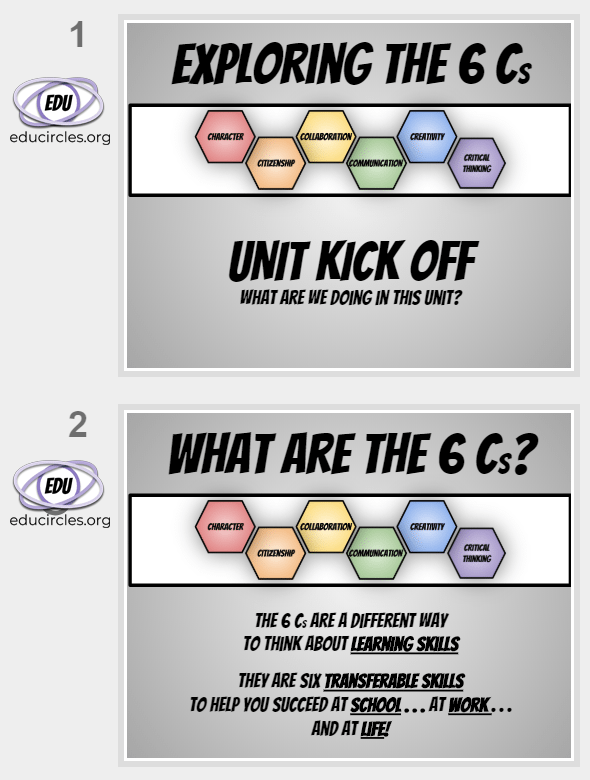
In the next unit, we’re going to be exploring something called the six “C’s.
The six Cs are a bunch of skills that you can use at school, at home, at a job… pretty much anywhere.
They’re learning skills that some people think you’re going to need to be successful in the 21st century.
This year, you’re going to be learning a lot of stuff in class. You’re going to be learning about English, Math, Science, Geography, Phys Ed, Art, Music, etc etc.
- The provincial / state curriculum tells us what you’re going to learn at school.
- The six Cs are about HOW to learn and do things.
The six Cs are things that everyone can do and should do. And, if you can start to learn and develop these skills at school, you’ll find you can apply them at home, in relationships, now, and in the future.
Today’s lesson is just an overview of what we’re going to be doing for the next few weeks. I’m going to give you a road map so you know where we’re headed. (Sometimes, if students know what they’re going to be learning, it helps them to put things together.)
Each of the “C”s is in one of these hexagon icons. (Get it? Six Cs… six sides… hexagon…)
- Character (RED)
- Citizenship (ORANGE)
- Collaboration (YELLOW)
- Communication (GREEN)
- Creativity (BLUE)
- Critical Thinking (PURPLE)
In this unit, I’ve colour coded the hexagons. Pssst. Think rainbow.
- Actually, the rainbow metaphor is kind of cool because white light is composed of different colors: red, orange, yellow, green, blue, violet.
- And, just like white light, if you combine all 6 Cs, all of these learning skills, you’ll find that you can see better and do better.
- It’s easier to do things if you’re not running around in the dark.
You’ll notice there’s a lot of overlap between the 6 Cs and activities in this introduction. That’s because they’re all interconnected.
- It doesn’t really matter which “C” we start with but just for fun, we’re going to go alphabetically and spend some time looking at each “C”.
- You might find that when we do an activity, it reminds you of a different “C” than the one we’re focusing on. That’s ok. You can do one activity and find different “C”s that connect with it.
Teacher Tip: So, if your class has a favourite activity, feel free to use it again but with a different conversation focus.
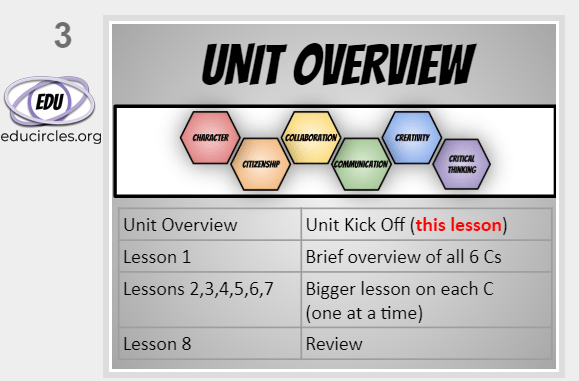
Here’s the big picture for what we will be learning in this unit.
Each “lesson” may take one class, or several classes, depending on the class, how interactive they are, and how long the periods are.
- For example, “Lesson 1” might take 6 classes – one class for each “C”.
- TEACHER TIP: You can switch around the order of the six Cs to meet your needs, or your school learning plan.
Lessons 2-7 look at each “C” one by one and each lesson has 3 parts: an activity, a video, and a vocabulary worksheet. Each of these parts could easily be a class onto itself.
At the very end, there is a review.
- TEACHER TIP: You can add an assessment component to this, if you like.

The first lesson is an overview of all six Cs. We will be doing an activity for each C to give you a taste of what that C is about.
Your job as we go through each C is to think about
- What each C has in common? (So, what does “character have in common with citizenship”?)
- How the Cs are different from each other? (So, what’s the difference between “collaboration” and “communication”?)

The next six lessons give you a deeper understanding of each “C” one at a time.
Each lesson actually has 3 parts and all of the lessons follow the same format:
- The first part is to experience the “C” (so, creativity, critical thinking, etc.)
- The second part is to watch the “C”
- And the last part is to develop a deeper understanding of the “C”
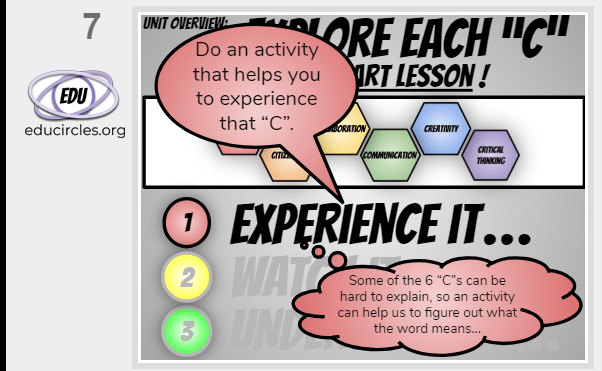
What does this actually mean?
During the first part, we’re going to do an activity that helps us experience that “C”
We do this because some of the Cs are hard to explain. (Like what’s the difference between collaboration and communication.)
So, an activity can help us figure out what the word means. (Like, I kind of know what critical thinking is… but, wait, what’s the difference between just regular thinking and “critical” thinking?) So, the activity gives us an idea of what the “C” is all about.
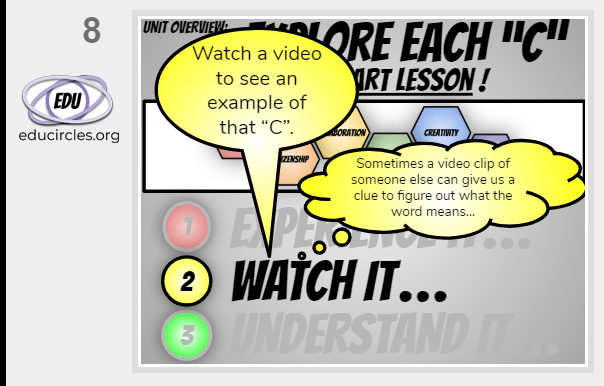
Next, we’re going to watch a video.
- Sometimes, seeing a video clip helps us to figure out what the concept is.
- Different people learn in different ways, so this might help some of us to get a better understanding of that “C”
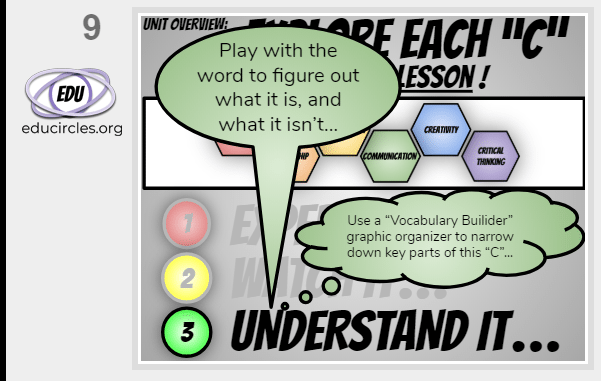
Finally, we’re going to play with the word to get a really good understanding of what the “C” is all about.
We’re going to use a graphic organizer to …
- play with our understanding of the “C” by brainstorming facts about the topic,
- clarify our understanding of the word by coming up with non-examples, and then
- communicate a more concise understanding of what the “C” means…
- and figure out which characteristics are the most essential to the “C” …
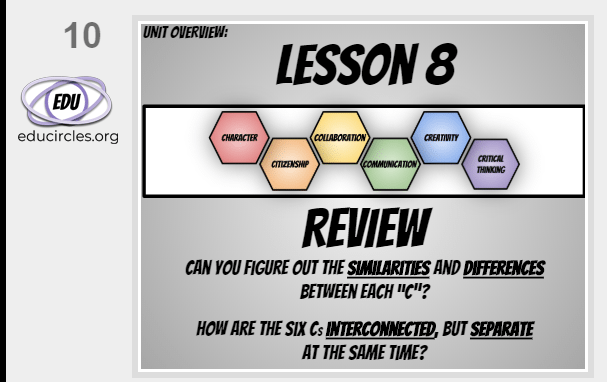
At the very end, we’re going to review the question we asked at the very begin with the introduction lesson:
- What do the six Cs have in common?
- How are the six Cs different from each other?
In other words, how are they interconnected with each other, but really separate at the same time?
Some very smart people in the world came up with these six Cs. (Not me) These are the skill sets they think we need to survive and thrive in the 21st century – anywhere in the world.
So, even though there are times when it seems like the Cs are the same thing (like communication and collaboration), it’s our job during this unit to try to figure out how they’re similar, but different at the same time.
The last unit is going to be an overview and review.
TEACHER TIP: You may choose to do an assessment at the end.
LESSON PLAN – REVIEW QUESTIONS
Let’s recap and see if you were paying attention!
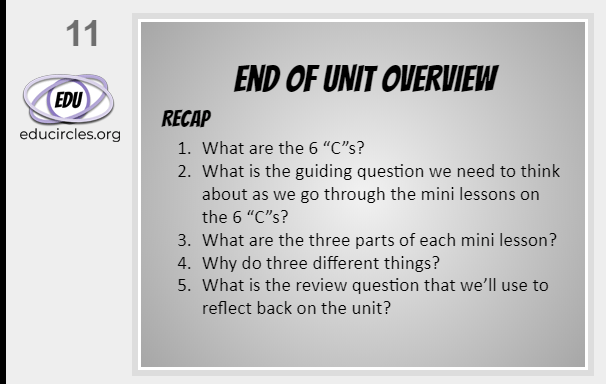
- What are the 6 “C”s?
- Character, Citizenship, Collaboration, Communication, Creativity, and Critical Thinking.
- Bonus question: Does the order matter? (No. Most activities can connect with multiple Cs, but we’re doing them in alphabetical order just for fun / to have structure to this unit.)
- What is the guiding question we need to think about as we go through the mini lessons on the 6 “C”s?
- Similarities and differences between the six Cs.
- What are the three parts of each mini lesson?
- Activity to experience the C.
- Watch a video to learn about the C in a different way
- Play with the word using a graphic organizer to get a better understanding of the C.
- Why do three different things?
- See answers above.
- Also because different people learn in different ways. So, the first way is active / kinesthetic, the second way is visual, and the third way is logical / verbal.
- What is the review question that we’ll use to reflect back on the unit?
- How are the six Cs interconnected, but separate at the same time?
DOWNLOAD THIS RESOURCE: (FREE) Exploring the Six Cs Unit Overview Lesson
Here’s what you get in a pretty zipped file:
- This lesson plan is available in PDF format for printing. Pretty.
- Customizable Powerpoint PPT file so you can change the slideshow to fit your classroom needs.
- Get a Google Slideshow link so you can present the slideshow as is, or make a copy of the Google Slideshow to modify it to fit your specific needs.
You will be taken to our Teachers Pay Teachers download site to get the zipped file.
Just give me the Google Slideshow link!
Don’t have time to download the full zipped file? No problem!
Just SHARE this page on social media and we’ll instantly give you the direct link to the Google Slideshow presentation used on this page.
NOTE: This link will only allow you to view the Google Slideshow presentation. You won’t be able to change or make a copy of the slideshow, yet. If you want to edit the slideshow, you’ll have to download the full zipped file from our download site to get a different link to our copiable version. (Is that even a word? Copy-able? You know what we mean.)